Shares in Splunk (NASDAQ:SPLK) have fallen 12.2% so far in 2021, 29.4% over the past 12 months and are 31% below the 12-month high. The stock is 35% above the YTD low close of $111.98, set on June 3 after reporting a significant earnings miss for Q1.
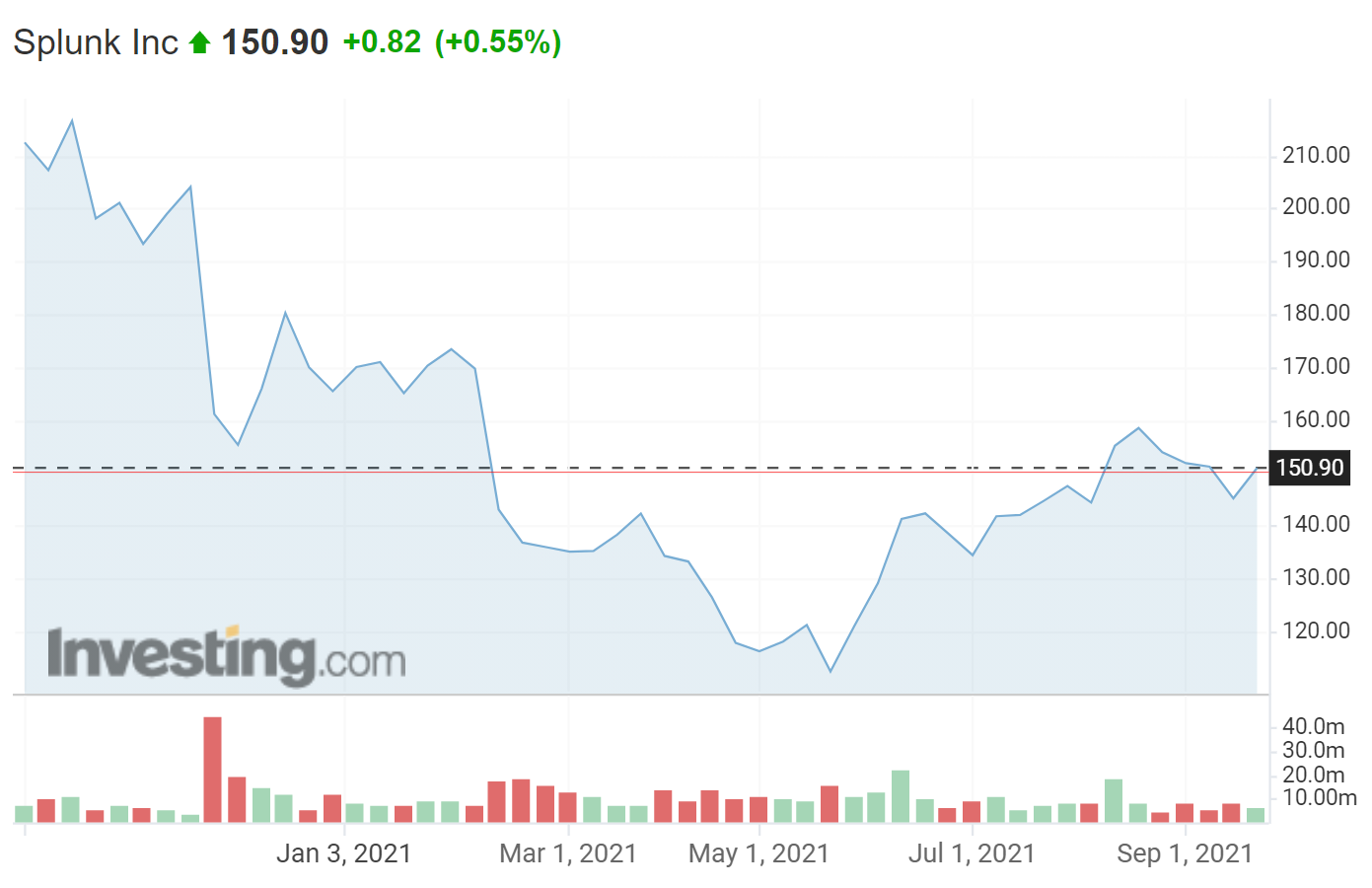
Source: Investing.com
Splunk provides software and services for data analysis and management, an area with enormous growth. The company’s shares have suffered a devaluation partly due to a slower-than-expected migration to the cloud and from software licenses to software as a service (SaaS). However, it is making rapid headway as its CEO says that the cloud is almost 50% of its business (also see this presentation). Analysts downgraded the stock in April of 2021 when the CTO left the company. The company is difficult to value, as are all growth stocks at this stage in their evolution because of the challenges in predicting revenue growth.
Wall Street analyst consensus has been continuously bullish over the past 12 months, as the share price collapsed to the low in June. When I last wrote about SPLK in March, the consensus 12-month price target for SPLK was about $199, 47% above the share price at that time.
Buyers and sellers of options express their outlooks on the underlying stock. Collectively, options prices can be used to derive an implicit probabilistic forecast. In early March, the options market was signaling a negative view. Balancing the bullish Wall Street consensus with the bearish options market outlook led me to assign a neutral rating at that time. In the 6 ¾ months since my article, SPLK has gained 11.85% vs. 12.22% for the S&P 500 (12.94% with dividends).
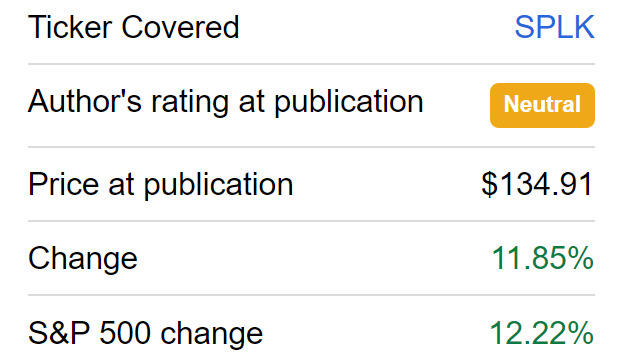
Source: Seeking Alpha
The Wall Street analyst consensus outlook is one view of the market. The options trading on a stock provides another. The price of an option represents the market’s consensus estimate for the probability that the price of the underlying stock (SPLK, in this case) will rise above (call option) or fall below (put option) a specific level (the strike price) between now and when the option expires.
By analyzing calls and puts at a range of strike prices and a common expiration date, it is possible to calculate a probabilistic outlook for the underlying security that reconciles the options prices. This is the market-implied outlook. For those who are unfamiliar with the concept, I have written an overview post, including links to the relevant financial literature.
It has been almost 7 months since my last analysis of SPLK and, as noted, the shares are about 30% below the trailing 12-month high. In this article, I am updating the market-implied outlook and the comparison to the Wall Street consensus.
Wall Street Consensus Outlook For SPLK
ETrade calculates the Wall Street consensus outlook from the views of 21 ranked analysts who have published ratings and 12-month price targets for SPLK within the past 90 days. The consensus rating is bullish and it has been continuously bullish over the past 12 months. The consensus 12-month price target is 20.3% above the current share price. The lowest of the analyst price targets is 1.39% above the current share price.
Of the 21 analysts, 15 assign a buy rating and 6 assign a hold rating. Qualitatively, ETrade’s Wall Street consensus outlook is similar to what it looked like in March, but the 12-month price target was 47% above the share price at that time.

Source: ETrade
Investing.com calculates the Wall Street consensus using ratings and price targets from 36 analysts. The consensus rating is bullish and the consensus 12-month price target is 18.6% above the current share price.

Source: Investing.com
The Wall Street consensus outlooks from ETrade and from Investing.com are very consistent, with a bullish rating and a 12-month price target that implies about a 19.5% gain over the next year (averaging the two).
Market-Implied Outlook For SPLK
I have analyzed call and put options at a range of strike prices, all expiring on Jan. 21, 2022, to calculate the market-implied outlook for the next 3.4 months (from now until Jan. 21, 2022). I have also analyzed options expiring on Sept. 16, 2022 to calculate the market-implied outlook for the next 11.1 months.
I chose to analyze the January options because these are fairly highly traded and because they provide an outlook to early 2022. I chose the September options to provide an (almost) one year outlook. The options expiring in September are thinly traded, however, so there is little confidence in the market-implied outlook at this time horizon.
The standard presentation of the market-implied outlook is in the form of a probability distribution of price return, with probability on the vertical axis and return on the horizontal.
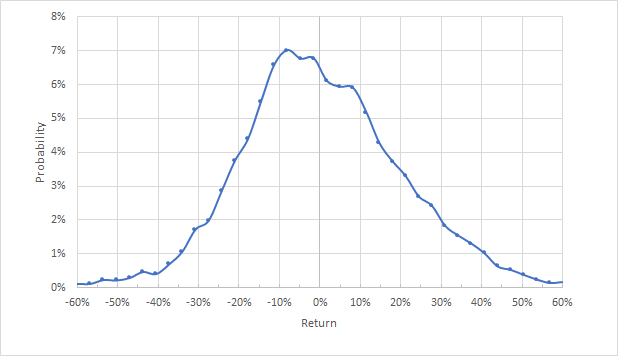
Source: Author’s calculations using options quotes from ETrade
The market-implied outlook for the next 3.4 months is generally symmetric, but the peak probabilities are tilted towards negative returns (a bearish indicator). The maximum probability corresponds to a price return of -8% for this period. The annualized volatility derived from this distribution is 41%, which is quite high for an individual stock. ETrade calculates a value of 39% for the implied volatility of the options expiring on Jan. 21, 2022.
To make it easier to directly compare the probabilities of positive and negative returns, I rotate the negative return side of the distribution about the vertical axis (see chart below).
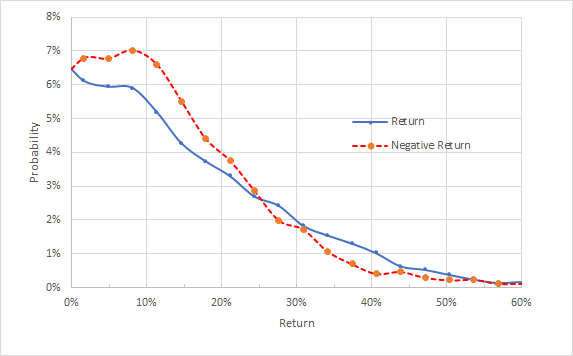
Source: Author’s calculations using options quotes from ETrade
From this view, it is evident that the probabilities of negative returns are consistently higher than for positive returns for a wide range of the most-probable outcomes (the red dashed curve is above the solid blue curve from 0% to about 25% on the horizontal axis on the chart above). The probability of very large positive returns is higher than for negative returns of the same magnitude (from 20% to 50% on the chart above), but the overall probability of these outcomes is low. This is a bearish market-implied outlook, although there is an asymmetric potential for a large upside surprise.
The market-implied outlook for next 11.1 months, calculated using options expiring in September, is not terribly robust due to the lack of active trading (so there are not a lot of participants expressing their implicit views). The market-implied outlook to September is an amplification of the bearish shorter-term outlook. The peak probability corresponds to a price return of about -26%. The annualized volatility derived from this distribution is 41%.
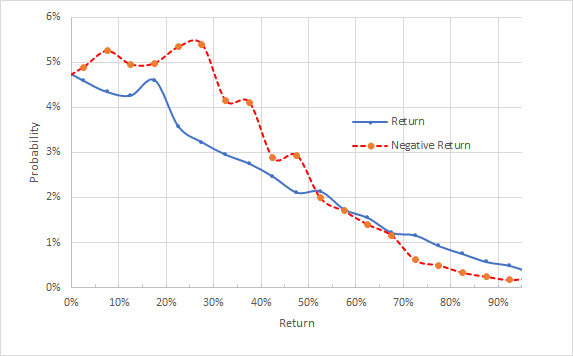
Source: Author's calculations using options quotes from ETrade
The chart above shows the market-implied price return probabilities for SPLK for the 11.1-month period from today until Sept. 16, 2022. The negative return side of the distribution has been rotated about the vertical axis.
The market-implied outlook for the next 3.4 months is bearish, with substantial volatility. The market-implied outlook for the next 11.1 months is also bearish, although the confidence in this longer-term outlook is low.
Summary
High stock price volatility often reflects rapidly-changing views on a company’s prospects and SPLK falls into this category. Differences of opinion on the stock are evident in the contrast between the Wall Street consensus outlook and the implicit consensus of options traders reflected in the market-implied outlook.
While the company is demonstrating rapid growth, valuation is challenging. Similar to when I analyzed SPLK in March, the Wall Street consensus is bullish and the market-implied outlook is bearish. The Wall Street consensus for the 12-month projected return has gotten lower, going from 47% in March to about 19.5% today, reflecting a less optimistic growth outlook.
As a rule of thumb for a buy rating, I look for expected 12-month return (19.5%, using the Wall Street consensus) that is at least ½ the projected volatility (41% from the market-implied outlook). Even taking the bullish Wall Street price target at face value, the expected return does not quite meet my criterion for an attractive risk/return balance. The market-implied outlook is bearish. I am maintaining my neutral rating on SPLK.
